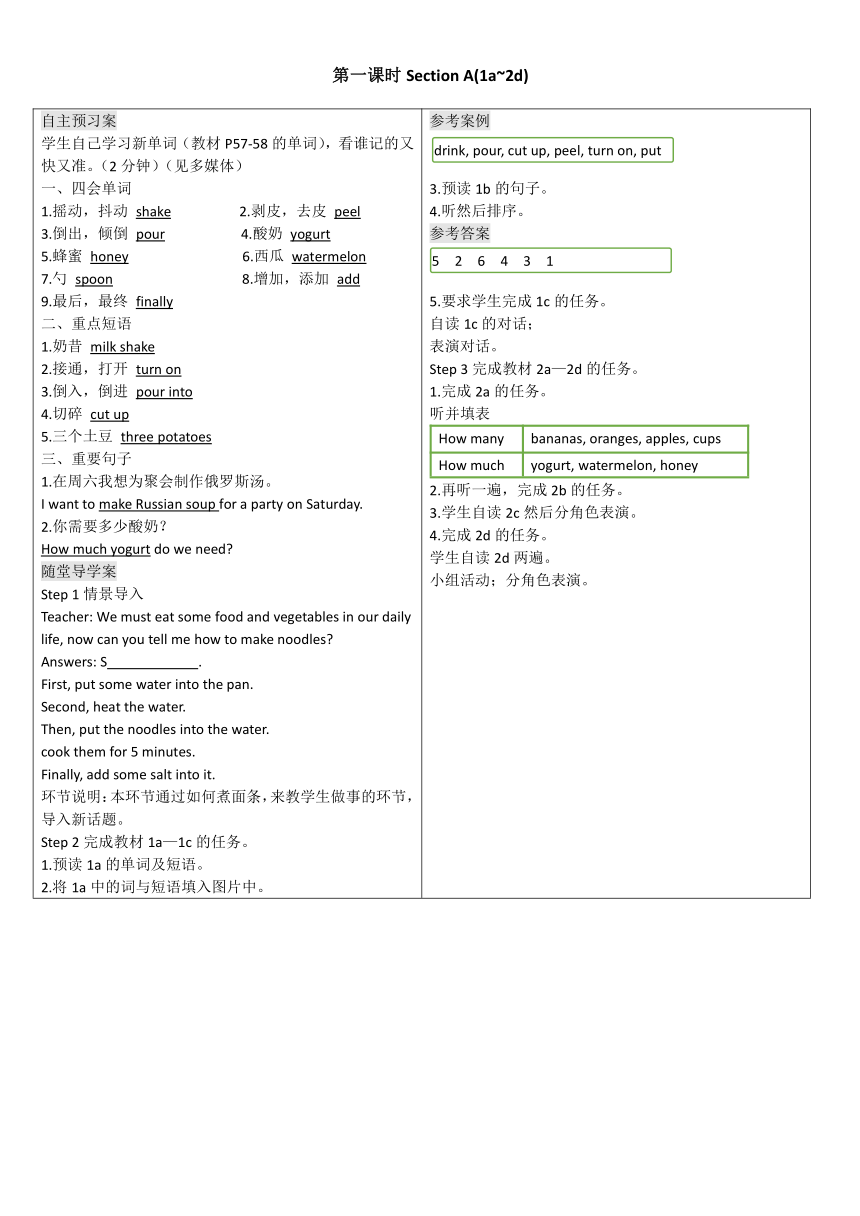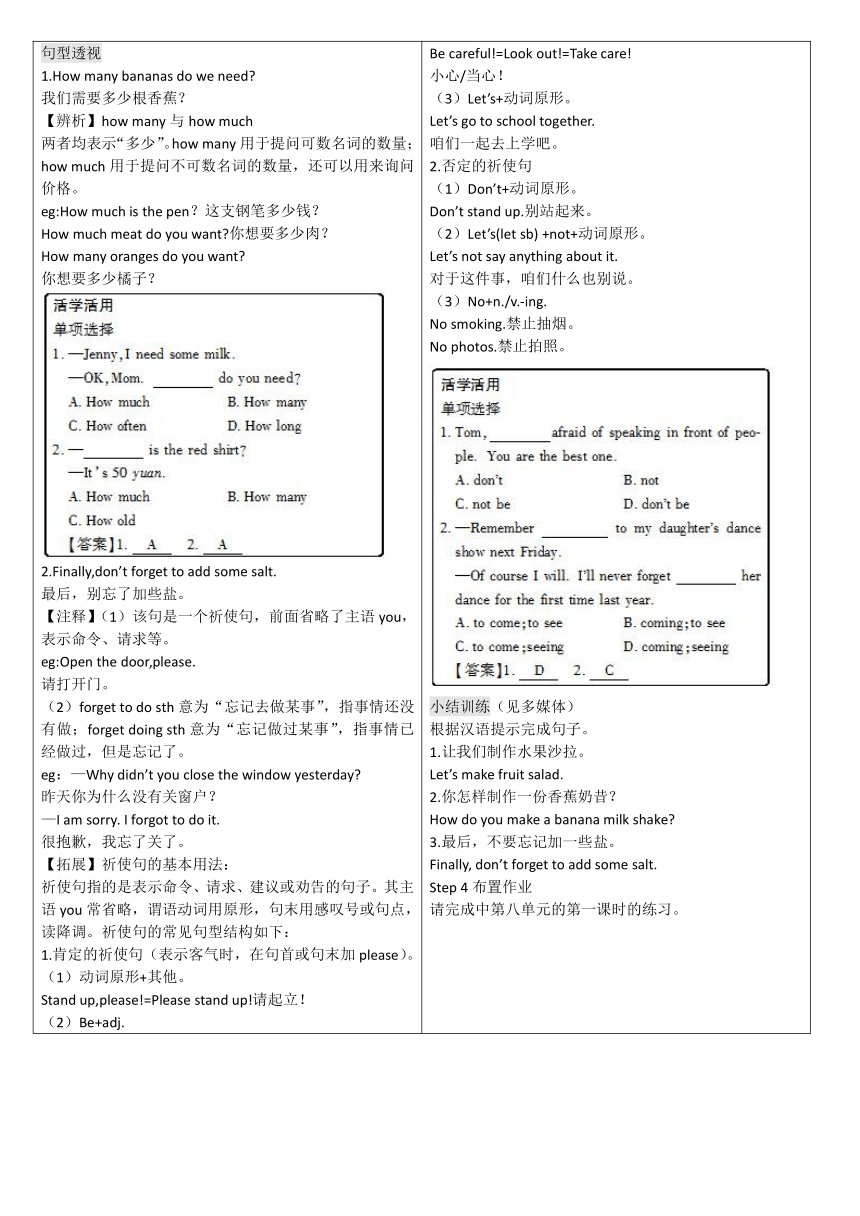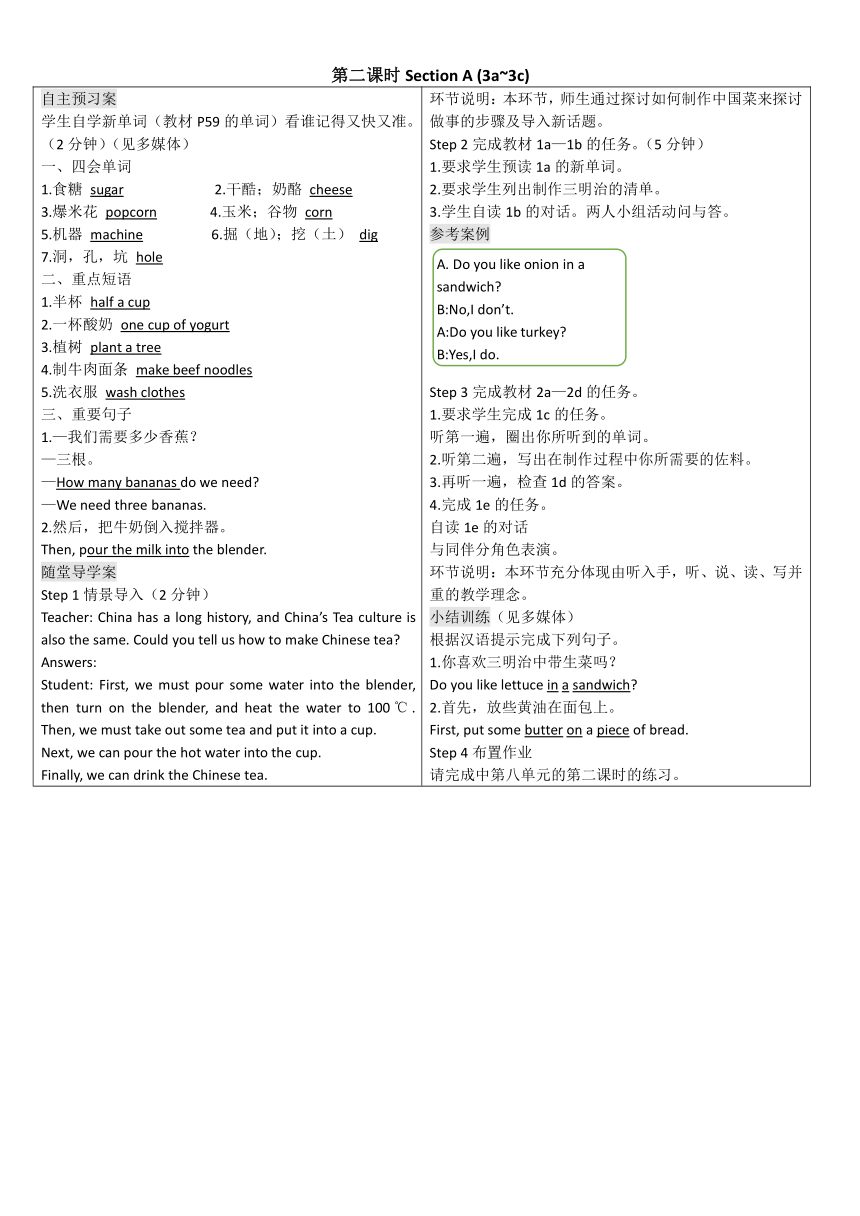人教版八年级上册 Unit 8 How do you make a banana milk shake?单元导学案
文档属性
| 名称 | 人教版八年级上册 Unit 8 How do you make a banana milk shake?单元导学案 |  | |
| 格式 | doc | ||
| 文件大小 | 105.4KB | ||
| 资源类型 | 教案 | ||
| 版本资源 | 人教新目标(Go for it)版 | ||
| 科目 | 英语 | ||
| 更新时间 | 2023-07-20 13:50:41 | ||
图片预览





文档简介
Unit 8 How do you make a banana milk shake
单元导学案
话题 How do you make a banana milk shake 你怎样制作奶昔?
四会单词 1.shake(n.&v.)摇(抖)动 2.pour(v.)倒出,倾倒 3.honey(n.)蜂蜜 4.watermelon(n.)西瓜 5.spoon(n.)勺,调羹 6.add(v.)添加;增加 7.finally(adv.)最后,最终 8.salt(n.)食盐 9.cheese(n.)干酷;奶酪 10.corn(n.)玉米;谷物 11.machine(n.)机器 12.hole(n.)洞,孔 13.sandwich(n.)三明治 14.butter(n.)黄油,奶油 15.piece(n.)片,块,段 16.traditional(adj.)传统的 17.autumn(n.)秋天 18.traveler(n.)游客 19.celebrate(v.)庆祝,庆贺 20.mix(v.)(使)混合 21.pepper(n.)甜椒 22.fill(v.)使充满 23.plate(n.)盘子,碟了 24.cover(n.)盖子 25.serve(v.)接待,服务 26.temperature(n.)温度,气温
重要短语 1.奶昔milk shake 2.剥香蕉皮peel bananas 3.打开,接通turn on 4.带蜂蜜的with honey 5.加……到add…to 6.一袋盐a bag of salt 7.挖洞dig a hole 8.传统节日a traditional festival 9.在秋天in autumn 10.用……装满fill…with 11.庆祝感恩节celebrate Thanksgiving 12.使……混合mix…up 13.用肉汁覆盖cover it with gravy 14.切成薄片cut…into thin pieces 15.来自英国的游客travelers from England
核心句子 1.Turn on (打开) the blender. 2.—How do you make(怎样制) a banana milk shake —First, peel the bananas… 3.—How much (多少) yogurt do we need —We need one cup of yogurt. 4.Finally, don’t forget (别忘了) to add some salt. 5.In most countries, people usually eat traditional food(传统食品) on special holidays. 6.It’s time to give(该定给) thanks for food in the autumn.
单元 语法 1.how many 与 how much的区别; 2.祈使句。
单元 重难点 重点:作事情的步骤:First,…Then…Next…Finally 难点:How to make Russian soup
第一课时Section A(1a~2d)
自主预习案 学生自己学习新单词(教材P57-58的单词),看谁记的又快又准。(2分钟)(见多媒体) 一、四会单词 1.摇动,抖动 shake 2.剥皮,去皮 peel 3.倒出,倾倒 pour 4.酸奶 yogurt 5.蜂蜜 honey 6.西瓜 watermelon 7.勺 spoon 8.增加,添加 add 9.最后,最终 finally 二、重点短语 1.奶昔 milk shake 2.接通,打开 turn on 3.倒入,倒进 pour into 4.切碎 cut up 5.三个土豆 three potatoes 三、重要句子 1.在周六我想为聚会制作俄罗斯汤。 I want to make Russian soup for a party on Saturday. 2.你需要多少酸奶? How much yogurt do we need 随堂导学案 Step 1情景导入 Teacher: We must eat some food and vegetables in our daily life, now can you tell me how to make noodles Answers: S . First, put some water into the pan. Second, heat the water. Then, put the noodles into the water. cook them for 5 minutes. Finally, add some salt into it. 环节说明:本环节通过如何煮面条,来教学生做事的环节,导入新话题。 Step 2完成教材1a—1c的任务。 1.预读1a的单词及短语。 2.将1a中的词与短语填入图片中。 参考案例 (
drink, pour, cut up, peel, turn on, put
) 3.预读1b的句子。 4.听然后排序。 参考答案 (
5
2
6
4
3
1
) 5.要求学生完成1c的任务。 自读1c的对话; 表演对话。 Step 3完成教材2a—2d的任务。 1.完成2a的任务。 听并填表 How manybananas, oranges, apples, cupsHow muchyogurt, watermelon, honey
2.再听一遍,完成2b的任务。 3.学生自读2c然后分角色表演。 4.完成2d的任务。 学生自读2d两遍。 小组活动;分角色表演。
Key Points: 词汇点睛 1.turn on 打开 eg:Turn on the blender.打开搅拌器。 【注释】turn on意为“打开”,多指打开水、煤气以及电灯、电炉、收音机等。这是动副短语,若其后接的宾语为名词,则名词既可放在turn和on之间,也可放在on之后;若宾语是代词,则代词只能放在turn和on之间。其反义词是turn off。 【拓展】(1)本单元出现的其他动副短语: cut up;mix up;take out。 (2)与turn相关的其他短语: turn up把(音量)调大;turn down把(音量)调小; turn in上交;take turns依次,轮流 2.pour v.倾倒 eg:Pour the milk into the blender. 把牛奶倒入搅拌器。 Please pour the cold water out. 请把凉水倒出来。 【注释】pour…into…意为“把……倒入……;把……灌入……”;pour…out意为“把……倒出”。 3.add v.增加;添加 eg:Don’t forget to add some salt. 别忘了加些盐。 Add these to the sandwich. 把这些加到三明治里。 The music added to enjoyment. 音乐给我们增添了欢乐。 【注释】通过观察以上例句,我们发现add…to…译为“把……加入……”;add to 意为“增添,增加”。
句型透视 1.How many bananas do we need 我们需要多少根香蕉? 【辨析】how many与how much 两者均表示“多少”。how many用于提问可数名词的数量;how much用于提问不可数名词的数量,还可以用来询问价格。 eg:How much is the pen?这支钢笔多少钱? How much meat do you want 你想要多少肉? How many oranges do you want 你想要多少橘子? 2.Finally,don’t forget to add some salt. 最后,别忘了加些盐。 【注释】(1)该句是一个祈使句,前面省略了主语you,表示命令、请求等。 eg:Open the door,please. 请打开门。 (2)forget to do sth意为“忘记去做某事”,指事情还没有做;forget doing sth意为“忘记做过某事”,指事情已经做过,但是忘记了。 eg:—Why didn’t you close the window yesterday 昨天你为什么没有关窗户? —I am sorry. I forgot to do it. 很抱歉,我忘了关了。 【拓展】祈使句的基本用法: 祈使句指的是表示命令、请求、建议或劝告的句子。其主语you常省略,谓语动词用原形,句末用感叹号或句点,读降调。祈使句的常见句型结构如下: 1.肯定的祈使句(表示客气时,在句首或句末加please)。 (1)动词原形+其他。 Stand up,please!=Please stand up!请起立! (2)Be+adj. Be careful!=Look out!=Take care! 小心/当心! (3)Let’s+动词原形。 Let’s go to school together. 咱们一起去上学吧。 2.否定的祈使句 (1)Don’t+动词原形。 Don’t stand up.别站起来。 (2)Let’s(let sb) +not+动词原形。 Let’s not say anything about it. 对于这件事,咱们什么也别说。 (3)No+n./v.-ing. No smoking.禁止抽烟。 No photos.禁止拍照。 小结训练(见多媒体) 根据汉语提示完成句子。 1.让我们制作水果沙拉。 Let’s make fruit salad. 2.你怎样制作一份香蕉奶昔? How do you make a banana milk shake 3.最后,不要忘记加一些盐。 Finally, don’t forget to add some salt. Step 4布置作业 请完成中第八单元的第一课时的练习。
第二课时Section A (3a~3c)
自主预习案 学生自学新单词(教材P59的单词)看谁记得又快又准。(2分钟)(见多媒体) 一、四会单词 1.食糖 sugar 2.干酷;奶酪 cheese 3.爆米花 popcorn 4.玉米;谷物 corn 5.机器 machine 6.掘(地);挖(土) dig 7.洞,孔,坑 hole 二、重点短语 1.半杯 half a cup 2.一杯酸奶 one cup of yogurt 3.植树 plant a tree 4.制牛肉面条 make beef noodles 5.洗衣服 wash clothes 三、重要句子 1.—我们需要多少香蕉? —三根。 —How many bananas do we need —We need three bananas. 2.然后,把牛奶倒入搅拌器。 Then, pour the milk into the blender. 随堂导学案 Step 1情景导入(2分钟) Teacher: China has a long history, and China’s Tea culture is also the same. Could you tell us how to make Chinese tea Answers: Student: First, we must pour some water into the blender, then turn on the blender, and heat the water to 100℃. Then, we must take out some tea and put it into a cup. Next, we can pour the hot water into the cup. Finally, we can drink the Chinese tea. 环节说明:本环节,师生通过探讨如何制作中国菜来探讨做事的步骤及导入新话题。 Step 2完成教材1a—1b的任务。(5分钟) 1.要求学生预读1a的新单词。 2.要求学生列出制作三明治的清单。 3.学生自读1b的对话。两人小组活动问与答。 参考案例 (
A. Do you like onion in a sandwich
B:No,I don’t.
A:Do you like turkey
B:Yes,I do.
) Step 3完成教材2a—2d的任务。 1.要求学生完成1c的任务。 听第一遍,圈出你所听到的单词。 2.听第二遍,写出在制作过程中你所需要的佐料。 3.再听一遍,检查1d的答案。 4.完成1e的任务。 自读1e的对话 与同伴分角色表演。 环节说明:本环节充分体现由听入手,听、说、读、写并重的教学理念。 小结训练(见多媒体) 根据汉语提示完成下列句子。 1.你喜欢三明治中带生菜吗? Do you like lettuce in a sandwich 2.首先,放些黄油在面包上。 First, put some butter on a piece of bread. Step 4布置作业 请完成中第八单元的第二课时的练习。
第三课时单元语法精讲与精练
(见P67)
第四课时Section B (1a~1e)
自主预习案 学生自己学习新单词(教材P60的单词),看谁记的又快又准。(3分钟)(见多媒体) 一、四会单词 1.夹心面包片;三明治 sandwich 2.黄油;奶油 butter 3.火鸡 turkey 4.片,块,段 piece 5.莴苣;生菜 lettuce 二、重点短语 1.在我的三明治中 in my sandwich 2.喜欢西红柿 like tomatoes 3.把……放在上 put …on 4.一片面包 a piece of bread 5.首先,……接着……最后…… First…Next…Finally 三、重要句子 1.—你喜欢三明治中的生菜吗?—是的。 —Do you like lettuce in a sandwich —Yes, I do. 2.—多少黄油?—大约一匙。 —How much butter —About one spoon. 随堂导学案 Step 1情景导入 1.教师通过图片向学生呈现新单词:(见多媒体) 如展示三明治(sandwich),火鸡(turkey),生菜(lettuce)等。 2.教师领读新单词。(教师一遍,学生三遍) 环节说明:此环节,教师直观呈现,便于学生识记。 Step 2完成教材1a—1b的任务。 1.要求学生预读1a内容。 2.要求学生完成1a的任务。 (
1.In my sandwich, I like lettuce in it.
2.In my sandwich, I like turkey in it.
3.In my sandwich, I like onion in it…
)参考案例 3.要求学生完成1b。 让学生自读1b的对话; 让学生分角色表演。 Step 3完成教材1c—1e的任务。(5分钟) 1.看1a的图片; 2.听并圈出你所听到的单词。 3.再听一遍,完成1d的表格。 4.要求学生完成1e的任务。 学生自读1e; 分角色表演1e。 环节说明:本环节,采取循序渐进的听的原则,一步步地完成听的任务。
Key Points: 词汇点睛 1.piece n.片;块;段 eg:First, put some butter on a piece of bread. 首先,在一片面包上放些黄油。 【注释】piece是可数名词,若表示名词的数量,用“数词+piece(s)+of+名词”结构。 【拓展】与“数词+piece(s)+of+名词”用法相类似的短语; “数词+cup(s)+of+名词”; “数词+glass(es)+of+名词”; “数词+bag(s)+of+名词”; “数词+box(es)+of+名词”; “数词+bottle(s)+of+名词”; “数词+slice(s)+of+名词”。 【辨析】a slice of与a piece of a slice of意为“一薄片……”,用于修饰面包或肉类; a piece of意为“一片……”,不强调薄厚,还有“一篇/首……”的意思。 eg: two slices of chicken=two chicken slices 两片鸡肉 a piece of news/music/paper 一则新闻/一段音乐/一张纸 句型透视 1.In most countries, people usually eat traditional food on special holidays. 在大多数国家,人们通常在特殊的节日里吃传统食品。 【注释】(1)traditional为形容词,意为“传统的;惯例的”,其名词是tradition。 (2)special在此处用作形容词,意为“特别的;特殊的”,后接名词,作定语。 eg: She is a special friend of mine. 她是我的一个特别的朋友。 【拓展】special还可用作名词,意为“特色菜”。 eg: We have a few specials on the menu this evening. 今天晚上我们有几个特色菜。 2.When it is ready, place the turkey on a large plate and cover it with gravy. 当一切就绪,将火鸡放在一个大盘子上并用肉汁覆盖。 【注释】(1)place在此处用作及物动词,意为“放置”,表示将(某物)置于某处,相当于put。 eg:Place the books on the shelf, please. 请把书摆在书架上。 (2)place还可用作可数名词,意为“地点;位置”。 eg:We must find a place for this new picture. 我们必须找到一个地方放这张新照片。 (3)cover在此处用作及物动词,意为“遮盖;覆盖”,常与介词with搭配,构成cover sb/sth with…,意为“用……把某人或某物盖上(表示动作)”;be covered with…意为“……被……盖着(表示状态)”。 eg:Snow covered the fields. 积雪覆盖了田野。 Please cover the table with a white cloth. 请在桌子上铺一块白色的桌布。 小结训练(见多媒体) 根据汉语提示,完成下列句子。 1.—你喜欢土豆吗?—不。 —Do you like potatoes —No, I don’t. 2.首先,把些黄油放在面包上。 First, put some butter on a piece of bread. Step 4布置作业 请完成中第八单元的第四课时的练习。
第五课时Section B (2a~4))
自主预习案 学生自学新单词(教材P61-63的单词),看谁记的又快又准。(2分钟)(见多媒体) 一、四会单词 1.传统的 traditional 2.秋天,秋季 autumn 3.游客 traveler 4.英格兰 England 5.庆祝 celebrate 6.(使)混合 mix 7.甜椒 pepper 8.接待,服务 serve 9.气温,温度 temperature 二、重点短语 1.一个特殊日子 a special day 2.给予感谢 give thanks for 3.用……装满 fill…with 4.加工几小时 cook it for a few hours 5.用肉汁盖它 cover it with gravy 三、重要句子 1.在大多数国家,人们在特别的假期通常吃传统食品。 In most countries, people usually eat traditional food on special holidays. 2.最后,把火鸡切成薄片。 Finally, cut the turkey into thin pieces. 随堂导学案 Step 1情景导入 Teacher: We have some traditional festivals in China, Such as the Spring Festival, and we often eat dumplings. Do you know how to cook the dumplings Students: 1. You must buy some sweet dumplings in the store. 2. Put some water in a pan on an oven and cook it for a few minutes. 3. When the water is boiled, put the dumplings into it. 4. Cook them for five minutes and add some sugar into it. 5. You can eat and taste them. Step 2完成教材2a—2e的任务。(5分钟) 1.要求学生谈论2a的问题。 2.学生自读2b二遍。 3.要求学生完成2c的任务。 (
1.The people in the United States.
2.It is always on the fourth Thursday in November.
3.It is a time to give thanks for food in the autumn.
4.They celebrate the idea of giving thanks by having a big meal at home.
5.It is almost always turkey, a large bird.
)参考答案 4.要求学生完成2d的任务。 5.要求学生完成2e的任务。 Step 3完成教材3a—4的任务。(5分钟) 1.学生完成3a的任务。 参考案例 (
have, First, wash, Next, cut, cook, Finally, enjoy
) 2.完成3b的任务,谈论家乡特色菜。 3.写菜谱,完成3c的任务。 4.完成4的任务。
Key Points: 词汇点睛 1.fill v.充满;填满 eg:Next, fill the turkey with this bread mix. 下一步,用面包混合配料装满火鸡。 The room was filled with people. 房间里挤满了人。 【注释】通过观察以上例句,我们发现fill译为“(使)充满;装满”,常与介词with搭配。 (1)fill…with…用……装满……(表示动作) (2)be filled with=be full of充满……(表示状态) 【拓展】fill还可以表示“填表”,构成 fill in。 eg: He told me to fill in the form. 他告诉我填那张表。 句型透视 1.Now,it’s time to enjoy the rice noodles! 现在,是享受米线的时候了! 【注释】“It’s time(for sb) to do sth.”意为“是(某人)做某事的时间了。”此句型有时可与“It’s time for sth.”句型进行同义转换。 eg:It’s time for lunch. =It’s time to have lunch. 该吃午饭了。 小结训练(见多媒体) 根据汉语提示完成下列句子。 1.现在是该享用米面的时候了。 Now, it’s time to enjoy the rice noodles. 2.在美国一个特殊的日子就是感恩节。 A special day in the United States is Thanksgiving. Step 4布置作业 请完成第八单元的第五课时的练习。
单元导学案
话题 How do you make a banana milk shake 你怎样制作奶昔?
四会单词 1.shake(n.&v.)摇(抖)动 2.pour(v.)倒出,倾倒 3.honey(n.)蜂蜜 4.watermelon(n.)西瓜 5.spoon(n.)勺,调羹 6.add(v.)添加;增加 7.finally(adv.)最后,最终 8.salt(n.)食盐 9.cheese(n.)干酷;奶酪 10.corn(n.)玉米;谷物 11.machine(n.)机器 12.hole(n.)洞,孔 13.sandwich(n.)三明治 14.butter(n.)黄油,奶油 15.piece(n.)片,块,段 16.traditional(adj.)传统的 17.autumn(n.)秋天 18.traveler(n.)游客 19.celebrate(v.)庆祝,庆贺 20.mix(v.)(使)混合 21.pepper(n.)甜椒 22.fill(v.)使充满 23.plate(n.)盘子,碟了 24.cover(n.)盖子 25.serve(v.)接待,服务 26.temperature(n.)温度,气温
重要短语 1.奶昔milk shake 2.剥香蕉皮peel bananas 3.打开,接通turn on 4.带蜂蜜的with honey 5.加……到add…to 6.一袋盐a bag of salt 7.挖洞dig a hole 8.传统节日a traditional festival 9.在秋天in autumn 10.用……装满fill…with 11.庆祝感恩节celebrate Thanksgiving 12.使……混合mix…up 13.用肉汁覆盖cover it with gravy 14.切成薄片cut…into thin pieces 15.来自英国的游客travelers from England
核心句子 1.Turn on (打开) the blender. 2.—How do you make(怎样制) a banana milk shake —First, peel the bananas… 3.—How much (多少) yogurt do we need —We need one cup of yogurt. 4.Finally, don’t forget (别忘了) to add some salt. 5.In most countries, people usually eat traditional food(传统食品) on special holidays. 6.It’s time to give(该定给) thanks for food in the autumn.
单元 语法 1.how many 与 how much的区别; 2.祈使句。
单元 重难点 重点:作事情的步骤:First,…Then…Next…Finally 难点:How to make Russian soup
第一课时Section A(1a~2d)
自主预习案 学生自己学习新单词(教材P57-58的单词),看谁记的又快又准。(2分钟)(见多媒体) 一、四会单词 1.摇动,抖动 shake 2.剥皮,去皮 peel 3.倒出,倾倒 pour 4.酸奶 yogurt 5.蜂蜜 honey 6.西瓜 watermelon 7.勺 spoon 8.增加,添加 add 9.最后,最终 finally 二、重点短语 1.奶昔 milk shake 2.接通,打开 turn on 3.倒入,倒进 pour into 4.切碎 cut up 5.三个土豆 three potatoes 三、重要句子 1.在周六我想为聚会制作俄罗斯汤。 I want to make Russian soup for a party on Saturday. 2.你需要多少酸奶? How much yogurt do we need 随堂导学案 Step 1情景导入 Teacher: We must eat some food and vegetables in our daily life, now can you tell me how to make noodles Answers: S . First, put some water into the pan. Second, heat the water. Then, put the noodles into the water. cook them for 5 minutes. Finally, add some salt into it. 环节说明:本环节通过如何煮面条,来教学生做事的环节,导入新话题。 Step 2完成教材1a—1c的任务。 1.预读1a的单词及短语。 2.将1a中的词与短语填入图片中。 参考案例 (
drink, pour, cut up, peel, turn on, put
) 3.预读1b的句子。 4.听然后排序。 参考答案 (
5
2
6
4
3
1
) 5.要求学生完成1c的任务。 自读1c的对话; 表演对话。 Step 3完成教材2a—2d的任务。 1.完成2a的任务。 听并填表 How manybananas, oranges, apples, cupsHow muchyogurt, watermelon, honey
2.再听一遍,完成2b的任务。 3.学生自读2c然后分角色表演。 4.完成2d的任务。 学生自读2d两遍。 小组活动;分角色表演。
Key Points: 词汇点睛 1.turn on 打开 eg:Turn on the blender.打开搅拌器。 【注释】turn on意为“打开”,多指打开水、煤气以及电灯、电炉、收音机等。这是动副短语,若其后接的宾语为名词,则名词既可放在turn和on之间,也可放在on之后;若宾语是代词,则代词只能放在turn和on之间。其反义词是turn off。 【拓展】(1)本单元出现的其他动副短语: cut up;mix up;take out。 (2)与turn相关的其他短语: turn up把(音量)调大;turn down把(音量)调小; turn in上交;take turns依次,轮流 2.pour v.倾倒 eg:Pour the milk into the blender. 把牛奶倒入搅拌器。 Please pour the cold water out. 请把凉水倒出来。 【注释】pour…into…意为“把……倒入……;把……灌入……”;pour…out意为“把……倒出”。 3.add v.增加;添加 eg:Don’t forget to add some salt. 别忘了加些盐。 Add these to the sandwich. 把这些加到三明治里。 The music added to enjoyment. 音乐给我们增添了欢乐。 【注释】通过观察以上例句,我们发现add…to…译为“把……加入……”;add to 意为“增添,增加”。
句型透视 1.How many bananas do we need 我们需要多少根香蕉? 【辨析】how many与how much 两者均表示“多少”。how many用于提问可数名词的数量;how much用于提问不可数名词的数量,还可以用来询问价格。 eg:How much is the pen?这支钢笔多少钱? How much meat do you want 你想要多少肉? How many oranges do you want 你想要多少橘子? 2.Finally,don’t forget to add some salt. 最后,别忘了加些盐。 【注释】(1)该句是一个祈使句,前面省略了主语you,表示命令、请求等。 eg:Open the door,please. 请打开门。 (2)forget to do sth意为“忘记去做某事”,指事情还没有做;forget doing sth意为“忘记做过某事”,指事情已经做过,但是忘记了。 eg:—Why didn’t you close the window yesterday 昨天你为什么没有关窗户? —I am sorry. I forgot to do it. 很抱歉,我忘了关了。 【拓展】祈使句的基本用法: 祈使句指的是表示命令、请求、建议或劝告的句子。其主语you常省略,谓语动词用原形,句末用感叹号或句点,读降调。祈使句的常见句型结构如下: 1.肯定的祈使句(表示客气时,在句首或句末加please)。 (1)动词原形+其他。 Stand up,please!=Please stand up!请起立! (2)Be+adj. Be careful!=Look out!=Take care! 小心/当心! (3)Let’s+动词原形。 Let’s go to school together. 咱们一起去上学吧。 2.否定的祈使句 (1)Don’t+动词原形。 Don’t stand up.别站起来。 (2)Let’s(let sb) +not+动词原形。 Let’s not say anything about it. 对于这件事,咱们什么也别说。 (3)No+n./v.-ing. No smoking.禁止抽烟。 No photos.禁止拍照。 小结训练(见多媒体) 根据汉语提示完成句子。 1.让我们制作水果沙拉。 Let’s make fruit salad. 2.你怎样制作一份香蕉奶昔? How do you make a banana milk shake 3.最后,不要忘记加一些盐。 Finally, don’t forget to add some salt. Step 4布置作业 请完成中第八单元的第一课时的练习。
第二课时Section A (3a~3c)
自主预习案 学生自学新单词(教材P59的单词)看谁记得又快又准。(2分钟)(见多媒体) 一、四会单词 1.食糖 sugar 2.干酷;奶酪 cheese 3.爆米花 popcorn 4.玉米;谷物 corn 5.机器 machine 6.掘(地);挖(土) dig 7.洞,孔,坑 hole 二、重点短语 1.半杯 half a cup 2.一杯酸奶 one cup of yogurt 3.植树 plant a tree 4.制牛肉面条 make beef noodles 5.洗衣服 wash clothes 三、重要句子 1.—我们需要多少香蕉? —三根。 —How many bananas do we need —We need three bananas. 2.然后,把牛奶倒入搅拌器。 Then, pour the milk into the blender. 随堂导学案 Step 1情景导入(2分钟) Teacher: China has a long history, and China’s Tea culture is also the same. Could you tell us how to make Chinese tea Answers: Student: First, we must pour some water into the blender, then turn on the blender, and heat the water to 100℃. Then, we must take out some tea and put it into a cup. Next, we can pour the hot water into the cup. Finally, we can drink the Chinese tea. 环节说明:本环节,师生通过探讨如何制作中国菜来探讨做事的步骤及导入新话题。 Step 2完成教材1a—1b的任务。(5分钟) 1.要求学生预读1a的新单词。 2.要求学生列出制作三明治的清单。 3.学生自读1b的对话。两人小组活动问与答。 参考案例 (
A. Do you like onion in a sandwich
B:No,I don’t.
A:Do you like turkey
B:Yes,I do.
) Step 3完成教材2a—2d的任务。 1.要求学生完成1c的任务。 听第一遍,圈出你所听到的单词。 2.听第二遍,写出在制作过程中你所需要的佐料。 3.再听一遍,检查1d的答案。 4.完成1e的任务。 自读1e的对话 与同伴分角色表演。 环节说明:本环节充分体现由听入手,听、说、读、写并重的教学理念。 小结训练(见多媒体) 根据汉语提示完成下列句子。 1.你喜欢三明治中带生菜吗? Do you like lettuce in a sandwich 2.首先,放些黄油在面包上。 First, put some butter on a piece of bread. Step 4布置作业 请完成中第八单元的第二课时的练习。
第三课时单元语法精讲与精练
(见P67)
第四课时Section B (1a~1e)
自主预习案 学生自己学习新单词(教材P60的单词),看谁记的又快又准。(3分钟)(见多媒体) 一、四会单词 1.夹心面包片;三明治 sandwich 2.黄油;奶油 butter 3.火鸡 turkey 4.片,块,段 piece 5.莴苣;生菜 lettuce 二、重点短语 1.在我的三明治中 in my sandwich 2.喜欢西红柿 like tomatoes 3.把……放在上 put …on 4.一片面包 a piece of bread 5.首先,……接着……最后…… First…Next…Finally 三、重要句子 1.—你喜欢三明治中的生菜吗?—是的。 —Do you like lettuce in a sandwich —Yes, I do. 2.—多少黄油?—大约一匙。 —How much butter —About one spoon. 随堂导学案 Step 1情景导入 1.教师通过图片向学生呈现新单词:(见多媒体) 如展示三明治(sandwich),火鸡(turkey),生菜(lettuce)等。 2.教师领读新单词。(教师一遍,学生三遍) 环节说明:此环节,教师直观呈现,便于学生识记。 Step 2完成教材1a—1b的任务。 1.要求学生预读1a内容。 2.要求学生完成1a的任务。 (
1.In my sandwich, I like lettuce in it.
2.In my sandwich, I like turkey in it.
3.In my sandwich, I like onion in it…
)参考案例 3.要求学生完成1b。 让学生自读1b的对话; 让学生分角色表演。 Step 3完成教材1c—1e的任务。(5分钟) 1.看1a的图片; 2.听并圈出你所听到的单词。 3.再听一遍,完成1d的表格。 4.要求学生完成1e的任务。 学生自读1e; 分角色表演1e。 环节说明:本环节,采取循序渐进的听的原则,一步步地完成听的任务。
Key Points: 词汇点睛 1.piece n.片;块;段 eg:First, put some butter on a piece of bread. 首先,在一片面包上放些黄油。 【注释】piece是可数名词,若表示名词的数量,用“数词+piece(s)+of+名词”结构。 【拓展】与“数词+piece(s)+of+名词”用法相类似的短语; “数词+cup(s)+of+名词”; “数词+glass(es)+of+名词”; “数词+bag(s)+of+名词”; “数词+box(es)+of+名词”; “数词+bottle(s)+of+名词”; “数词+slice(s)+of+名词”。 【辨析】a slice of与a piece of a slice of意为“一薄片……”,用于修饰面包或肉类; a piece of意为“一片……”,不强调薄厚,还有“一篇/首……”的意思。 eg: two slices of chicken=two chicken slices 两片鸡肉 a piece of news/music/paper 一则新闻/一段音乐/一张纸 句型透视 1.In most countries, people usually eat traditional food on special holidays. 在大多数国家,人们通常在特殊的节日里吃传统食品。 【注释】(1)traditional为形容词,意为“传统的;惯例的”,其名词是tradition。 (2)special在此处用作形容词,意为“特别的;特殊的”,后接名词,作定语。 eg: She is a special friend of mine. 她是我的一个特别的朋友。 【拓展】special还可用作名词,意为“特色菜”。 eg: We have a few specials on the menu this evening. 今天晚上我们有几个特色菜。 2.When it is ready, place the turkey on a large plate and cover it with gravy. 当一切就绪,将火鸡放在一个大盘子上并用肉汁覆盖。 【注释】(1)place在此处用作及物动词,意为“放置”,表示将(某物)置于某处,相当于put。 eg:Place the books on the shelf, please. 请把书摆在书架上。 (2)place还可用作可数名词,意为“地点;位置”。 eg:We must find a place for this new picture. 我们必须找到一个地方放这张新照片。 (3)cover在此处用作及物动词,意为“遮盖;覆盖”,常与介词with搭配,构成cover sb/sth with…,意为“用……把某人或某物盖上(表示动作)”;be covered with…意为“……被……盖着(表示状态)”。 eg:Snow covered the fields. 积雪覆盖了田野。 Please cover the table with a white cloth. 请在桌子上铺一块白色的桌布。 小结训练(见多媒体) 根据汉语提示,完成下列句子。 1.—你喜欢土豆吗?—不。 —Do you like potatoes —No, I don’t. 2.首先,把些黄油放在面包上。 First, put some butter on a piece of bread. Step 4布置作业 请完成中第八单元的第四课时的练习。
第五课时Section B (2a~4))
自主预习案 学生自学新单词(教材P61-63的单词),看谁记的又快又准。(2分钟)(见多媒体) 一、四会单词 1.传统的 traditional 2.秋天,秋季 autumn 3.游客 traveler 4.英格兰 England 5.庆祝 celebrate 6.(使)混合 mix 7.甜椒 pepper 8.接待,服务 serve 9.气温,温度 temperature 二、重点短语 1.一个特殊日子 a special day 2.给予感谢 give thanks for 3.用……装满 fill…with 4.加工几小时 cook it for a few hours 5.用肉汁盖它 cover it with gravy 三、重要句子 1.在大多数国家,人们在特别的假期通常吃传统食品。 In most countries, people usually eat traditional food on special holidays. 2.最后,把火鸡切成薄片。 Finally, cut the turkey into thin pieces. 随堂导学案 Step 1情景导入 Teacher: We have some traditional festivals in China, Such as the Spring Festival, and we often eat dumplings. Do you know how to cook the dumplings Students: 1. You must buy some sweet dumplings in the store. 2. Put some water in a pan on an oven and cook it for a few minutes. 3. When the water is boiled, put the dumplings into it. 4. Cook them for five minutes and add some sugar into it. 5. You can eat and taste them. Step 2完成教材2a—2e的任务。(5分钟) 1.要求学生谈论2a的问题。 2.学生自读2b二遍。 3.要求学生完成2c的任务。 (
1.The people in the United States.
2.It is always on the fourth Thursday in November.
3.It is a time to give thanks for food in the autumn.
4.They celebrate the idea of giving thanks by having a big meal at home.
5.It is almost always turkey, a large bird.
)参考答案 4.要求学生完成2d的任务。 5.要求学生完成2e的任务。 Step 3完成教材3a—4的任务。(5分钟) 1.学生完成3a的任务。 参考案例 (
have, First, wash, Next, cut, cook, Finally, enjoy
) 2.完成3b的任务,谈论家乡特色菜。 3.写菜谱,完成3c的任务。 4.完成4的任务。
Key Points: 词汇点睛 1.fill v.充满;填满 eg:Next, fill the turkey with this bread mix. 下一步,用面包混合配料装满火鸡。 The room was filled with people. 房间里挤满了人。 【注释】通过观察以上例句,我们发现fill译为“(使)充满;装满”,常与介词with搭配。 (1)fill…with…用……装满……(表示动作) (2)be filled with=be full of充满……(表示状态) 【拓展】fill还可以表示“填表”,构成 fill in。 eg: He told me to fill in the form. 他告诉我填那张表。 句型透视 1.Now,it’s time to enjoy the rice noodles! 现在,是享受米线的时候了! 【注释】“It’s time(for sb) to do sth.”意为“是(某人)做某事的时间了。”此句型有时可与“It’s time for sth.”句型进行同义转换。 eg:It’s time for lunch. =It’s time to have lunch. 该吃午饭了。 小结训练(见多媒体) 根据汉语提示完成下列句子。 1.现在是该享用米面的时候了。 Now, it’s time to enjoy the rice noodles. 2.在美国一个特殊的日子就是感恩节。 A special day in the United States is Thanksgiving. Step 4布置作业 请完成第八单元的第五课时的练习。
同课章节目录
- Unit 1 Where did you go on vacation?
- Section A
- Section B
- Unit 2 How often do you exercise?
- Section A
- Section B
- Unit 3 I'm more outgoing than my sister.
- Section A
- Section B
- Unit 4 What's the best movie theater?
- Section A
- Section B
- Unit 5 Do you want to watch a game show?
- Section A
- Section B
- Unit 6 I'm going to study computer science.
- Section A
- Section B
- Unit 7 Will people have robots?
- Section A
- Section B
- Unit 8 How do you make a banana milk shake?
- Section A
- Section B
- Unit 9 Can you come to my party?
- Section A
- Section B
- Unit 10 If you go to the party, you'll have a grea
- Section A
- Section B
